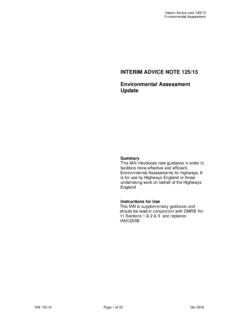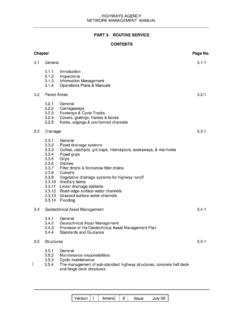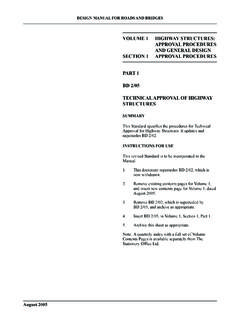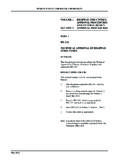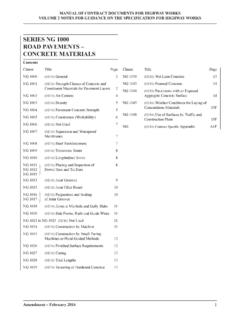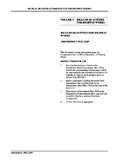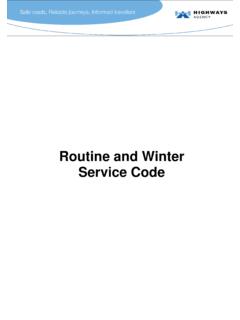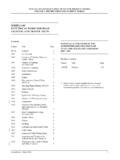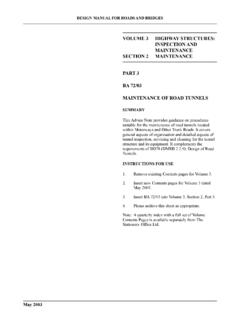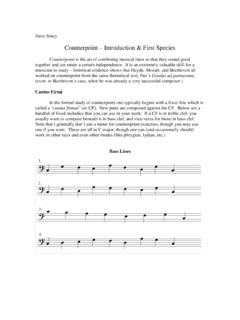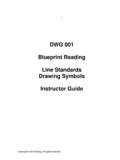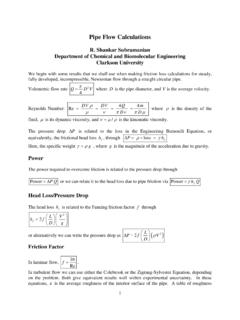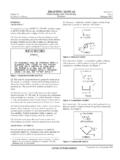Transcription of DMRB VOLUME 6 SECTION 1 PART 2 - TD 27/05 - …
1 February 2005 DESIGN MANUAL FOR ROADS AND BRIDGESVOLUME 6 ROAD GEOMETRYSECTION 1 LINKSPART 2TD 27/05 cross -SECTIONS AND HEADROOMSSUMMARYThis Standard sets out the dimensional requirements forthe highway cross -sections for all-purpose andmotorway trunk roads, both at and away fromstructures. It also gives requirements for headroom FOR Contents pages from VOLUME 6 andinsert new Contents page for VOLUME 6 datedFebruary TD 27/96 from VOLUME 6, SECTION 1which is superseded by this Standard andarchive as TD 27/05 into VOLUME 5, SECTION archive this sheet as :A quarterly index with a full set of VolumeContents Pages is available separately from TheStationery Office Ltd. TD 27/05 cross -Sections and HeadroomsSummary:This Standard sets out the dimensional requirements for the highwaycross-sections for all-purpose and motorway trunk roads, both at and awayfrom structures. It also gives requirements for headroom at MANUAL FOR ROADS AND BRIDGESTHE HIGHWAYS AGENCYSCOTTISH EXECUTIVEWELSH ASSEMBLY GOVERNMENTLLYWODRAETH CYNULLIAD CYMRUTHE DEPARTMENT FOR REGIONAL DEVELOPMENTNORTHERN IRELANDV olume 6 SECTION 1 Part 2 TD 27/05 February 2005 REGISTRATION OF AMENDMENTSA mendPage NoSignature & Date ofAmendPage NoSignature & Date ofNoincorporation ofNoincorporation ofamendmentsamendmentsRegistration of AmendmentsVolume 6 SECTION 1 Part 2 TD 27/05 February 2005 REGISTRATION OF AMENDMENTSA mendPage NoSignature & Date ofAmendPage NoSignature & Date ofNoincorporation ofNoincorporation ofamendmentsamendmentsRegistration of AmendmentsVOLUME 6 ROAD GEOMETRYSECTION 1 LINKSPART 2TD 27/05 cross -SECTIONS AND cross -Sections at at AFeatures Commonly Occurring in theHighway cross -SectionAnnex BRural Motorway Widening.
2 cross -Sectionand Layout at Physical RestraintsDESIGN MANUAL FOR ROADS AND BRIDGESF ebruary 2005 VOLUME 6 SECTION 1 Part 2 TD 27/05 February 20051/1 Chapter 1 Introduction1. Standard sets out the design principles andfactors that should be considered by DesignOrganisations in selecting highway cross -sections andheadrooms. The process of design is described togetherwith an approach to developing Standard supersedes TD 27/96. The majorchanges use of a modular system to describe theindividual components of the cross - SECTION ; acknowledgement that society demandsmeasures to permit better use of existing roads; guidance to encourage consideration offuture maintenance operations; widening of the road pavement in certaincircumstances for reasons of buildability and toaccommodate future traffic managementlayouts; on the need to fully consider andpromote facilities for non-motorised road users; way in which certain components of thecross- SECTION are measured; presentation of information has beenclarified and improved, with new Tables andadditional Figures; have been updated and extended:-guidance associated with reduced widthhardshoulders, central reserve and lanewidths to assist in the widening of ruralmotorways at short obstructions.
3 SeeAnnex B; and-advice given on the provision of Standard gives details of thecross-sections and headrooms to be used for all-purposeand motorway trunk roads, both at and away information covers trunk roads of all types:rural motorways, rural all-purpose roads, urbanmotorways and urban all-purpose roads, together withassociated connector cross - SECTION of side roads that are not partof the Overseeing Organisation s network should beagreed with the relevant Highway Authority. Furtherdetails are given in Chapter Standard is not applicable to road guidance see BD 78 ( dmrb ). details of pedestrian, cycle and equestriansubway dimensions see TD 36 ( dmrb ) andTA 91 ( dmrb ), for footbridges see BD 29( dmrb ), and for agricultural crossings see TA 5 7( dmrb ) and TA 56 ( dmrb ). standard does not give mandatoryrequirements for headroom near airports or at powerlines, but Annex A provides details of sources Standard must be used forthwith forthe design of all schemes for the construction andimprovement of all-purpose and motorway trunkroads currently being prepared, provided that in theopinion of the Overseeing Organisation, this wouldnot result in any significant additional expense ordelay.
4 The Design Organisation must confirm itsapplication to particular schemes with theOverseeing the definitions of the general highwayterms used in this Standard, such as highway types (trunk roads, motorway and all-purpose roads etc) andVolume 6 SECTION 1 Part 2 TD 27/05 February 20051/2 Chapter 1 Introduction components of the highway (hardshoulders,hardstrips and climbing lanes etc.), see BS 6100:Subsection terms used in this Standard aredefined as:Bridleway: Highway for use on foot or horseback(unless specifically prohibited, cyclists can also use abridleway but are required to give way to other users).Berm: Any nominally flat area between the back of theverge and the highway boundary at the top of a cuttingor the bottom of an Reserve: The area that separates thecarriageways of a dual carriageway exclusive of Road: Refer to TD 22 ( dmrb ). cross - SECTION : The assembly of the variouscomponents of the highway between the highwayboundaries, measured at right angles to the line of thehighway.
5 The cross - SECTION includes carriageways,central reserve, separator zones, hardshoulders,hardstrips, verges including any footway, cycle track orbridleway, cutting or embankment slopes and berms.(See Figure 4-1a to Figure 4-4b).CSRRS (Current Standard for Road RestraintSystems): Please refer to the Overseeing Organisations current standard for road restraint systems. Note: Wherediagrams within TD 27 show vehicle restraint systems,these are for illustrative purposes only and the CSRRS must be consulted to determine the appropriateness ofany Lane: A lane in the carriageway for use Track: A track separate from the maincarriageway for use by Organisation: The organisation commissionedto undertake the various phases of scheme Lanes: A lane reserved exclusively for useby designated vehicles such as cycles, buses, taxis,large goods vehicles and high occupancy : That part of the carriageway(s) wherethe traffic is flowing away from the cross - SECTION : The minimum distance between the surfaceof the highway cross - SECTION and the deflected structure(including any temporary or permanent attachments)measured at right angles to the surface of : Refer to TD 22 ( dmrb ).
6 Interchange Link: Refer to TD 22 ( dmrb ).Loops: Refer to TD 22 ( dmrb ).Mainline: The carriageway carrying the main flow oftraffic (generally traffic passing straight through ajunction or interchange).Maintained Headroom: The minimum value ofHeadroom that must be preserved at all : EITHER the area between the Paved Widthand an NMU route OR an area between two parallelNMU routes OR an area between an NMU route and aphysical Construction Headroom: The value ofHeadroom for new structures that includes an additionalallowance for future road realignment and : Left-hand side of vehicle when viewing aforward moving vehicle from behind, typically thefront-seat passenger side of the vehicle in the Users (NMUs): Pedestrians, cyclistsand equestrians including mobility impaired users asdefined in HD 42 ( dmrb ).Offside: Right-hand side of vehicle when viewing aforward moving vehicle from behind, typically thedriver s side of the vehicle in the : A bridge that spans the road Organisation: The Highway Authority forthe road construction or improvement Width: A collective term for the surface of theroad cross - SECTION that comprises the carriageway,hardshoulder and Width Headroom: The value of Headroom overthe Paved Tunnel: Refer to BD 2 ( dmrb ).
7 VOLUME 6 SECTION 1 Part 2 TD 27/05 February 2005 Rural Roads: All-purpose roads and motorways thatare generally not subject to a local speed limit. Refer toTA 46 ( dmrb ).Separator Zone: An area that separates traffic flows onthe mainline from an adjacent parallel road, Road: Refer to TD 22 ( dmrb ).Standard Headroom: Either Maintained Headroom orNew Construction Headroom, as : Any object with the primary purpose ofbearing loads. This includes bridges, footbridges,retaining walls and sign or signal gantries, but excludesmore frangible items such as deformable vehiclerestraint systems and small span Free Zone (SFZ): A buffer zone adjacent tothe Paved Width and beneath a Structure that reducesthe risk of errant vehicle impacts by providing anappropriate value of : Underground passageway or tunnel for use bypedestrians, cyclists and sometimes : A bridge that carries the road Roads: Refer to TA 79 ( dmrb ).Urban Motorway: A motorway with a speed limit of60 mph or less within a built-up All-Purpose Road (UAP): An all-purpose roadwithin a built-up area, either a single carriageway witha speed limit of 40mph or less or a dual-carriagewaywith a speed limit of 60mph or : That part of the carriageway(s) wheretraffic is flowing towards the cross - SECTION in Restraint System (VRS): Refer to : Any nominally flat area between the edge of thePaved Width and either the start of an adjacent sideslope or, in the absence of a side slope, the highwayboundary or bridge Highway Corridor: Any highway with five ormore lanes in any one Width: Refer to sections of this document arecontained in boxes.
8 The Design Organisation mustcomply with these sections or obtain agreement toa Departure from Standard from the OverseeingOrganisation. The remainder of the documentcontains advice and explanation, which iscommended to users for From exceptional situations, the OverseeingOrganisation may be prepared to agree to aDeparture from Standard where the standard,including permitted Relaxations, is not realisticallyachievable. Design Organisations faced by suchsituations and wishing to consider pursuing thiscourse must discuss any such option at an earlystage in design with the Overseeing to adopt Departures from Standard mustbe submitted by the Design Organisation to theOverseeing Organisation and formal approvalreceived BEFORE incorporation into a difficult circumstances Relaxations maybe introduced at the discretion of the DesignOrganisation, having regard to all relevant localfactors, but only where specifically permitted bythis Standard.
9 Careful consideration must be givento layout options incorporating Relaxations, havingweighed the benefits and any potential attention must be given to the safetyaspects (including operation, maintenance,construction and demolition) and theenvironmental and monetary benefits/disbenefitsthat would result from the use of Relaxations. Theconsideration process must be recorded. Thepreferred option must be compared against optionsthat would meet full 1 IntroductionVolume 6 SECTION 1 Part 2 TD 27/05 February 20052/1 Chapter 2 Design Principles2. DESIGN chapter describes the principles to befollowed when designing highway cross -sections fornew and improved all-purpose trunk roads cross - SECTION is made up from acombination of distinct components that varydepending upon the type of highway and the facilitiesprovided for the various users of the route. Somedecisions relating to the cross - SECTION are made duringproject development, such as the capacity and numberof lanes.
10 Other decisions, such as the type of road, aremade earlier in the Standard defines and describes thecomponents and presents guidance on details of theirdesign. The basic components are identified separatelyto simplify definition and interpretation as an aid todesign consistency and application. Differentarrangements of the components are to be useddepending on the functional classification of thehighway. The Design Organisation s role is to decidewhich of the components to include and the selection ofthe appropriate are many components in a highwayprovided for specific purposes and each involves anumber of interrelated design decisions. Integrating allthese components to satisfy the numerous competingdemands for highway space and functionality requirescarefully balanced decisions. Plate 2-1 provides anillustration to emphasize this included in the cross - SECTION canaffect the overall width and their relationship andinteraction is often complex.
